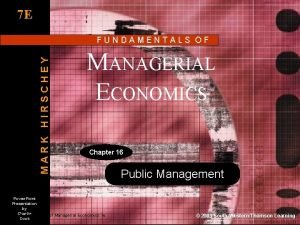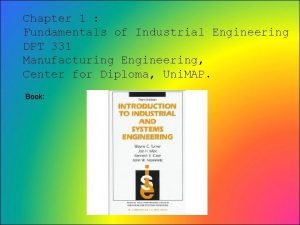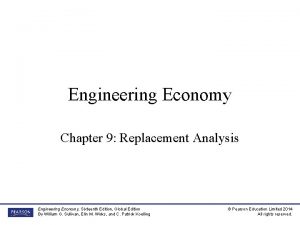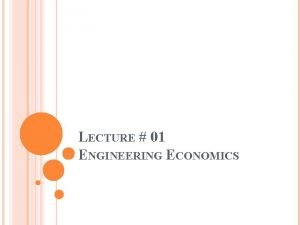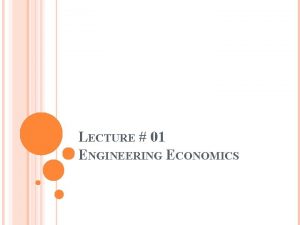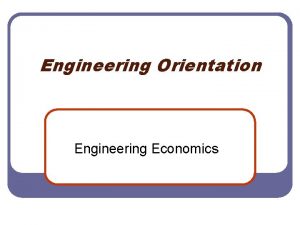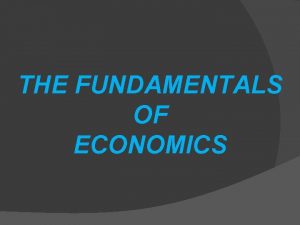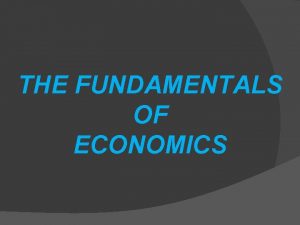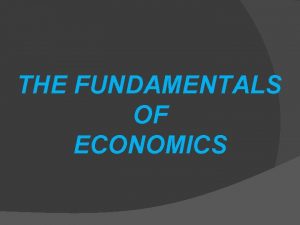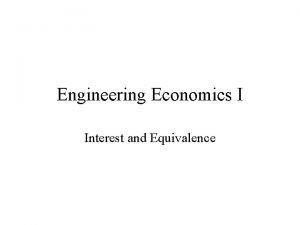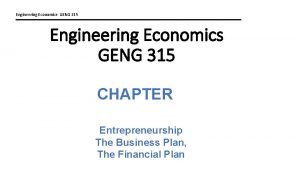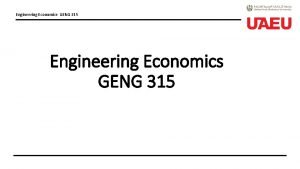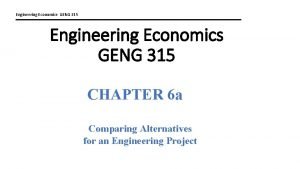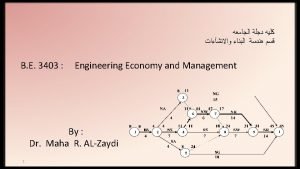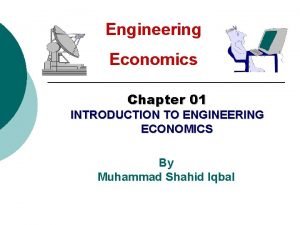1 Lecture 2 Engineering Economics 20 Fundamentals of
















- Slides: 16

1

Lecture # 2 Engineering Economics (2+0) Fundamentals of Engineering Economics-2 And Time value of Money Instructor: Prof. Dr. Attaullah Shah Department of Civil Engineering City University of Science and IT Peshawar 2

Engineering Economics n n n It deals with the concepts and techniques of analysis useful in evaluating the worth of systems, products, and services in relation to their costs Engineering economics deals with the methods that enable one to take economic decisions towards minimizing costs and/or maximizing benefits to business organizations. It is used to answer many different questions n n n Which Engineering projects are worthwhile? n Has the mining or petroleum engineer shown that the mineral or oil deposits is worth developing? Which engineering projects should have a higher priority? n Has the industrial engineer shown which factory improvement projects should be funded with the available dollars? How should the engineering project be designed? n Has civil or mechanical engineer chosen the best

Why Engineering Economy is Important to Engineers v v v Engineers design and create Designing involves economic decisions Engineers must be able to incorporate economic analysis into their creative efforts Often engineers must select and implement from multiple alternatives Understanding and applying time value of money, economic equivalence, and cost estimation are vital for engineers A proper economic analysis for selection and execution is a fundamental task of engineering

1. 2. 3. 4. 5. 6. 7. General Steps for Decision Making Processes Understand the problem – define objectives Collect relevant information Define the set of feasible alternatives Identify the criteria for decision making Evaluate the alternatives and apply sensitivity analysis Select the “best” alternative Implement the alternative and monitor results

Time Value of Money n What is money? n Money is any set of assets used to buy goods and services, and has three key characteristics. n First, money is a medium of exchange: it offers buyers and sellers a mutually recognized means of payment for exchanging goods and services. n Second, money is a unit of account, or a yardstick for measuring the value of goods and services to sellers and buyers. n Third, money is a store of value: it can be reliably saved, stored and predictably used once retrieved. Other desirable features of money are that it should have a stable value and be difficult to counterfeit.

What is The Time Value of Money? n A dollar received today is worth more than a dollar received tomorrow This is because a dollar received today can be invested to earn interest n The amount of interest earned depends on the rate of return that can be earned on the investment n n 7 Time value of money quantifies the value of a dollar through time

Uses of Time Value of Money n Time Value of Money, or TVM, is a concept that is used in all aspects of finance including: n n n 8 Bond valuation Stock valuation Accept/reject decisions for project management Financial analysis of firms And many others!

Formulas n Common formulas that are used in TVM calculations: * n Present value of a lump sum: PV = FV / (1+i) n n Future value of a lump sum: FV = PV * (1+i)n Present value of a cash flow stream: PV = S [FV / (1+i)n] 9

Equal-Payment Series Compound Amount n n n To determine Future worth “F” of equal payments “A” made at equal interval of times and compounded at the interest rate: F= Example: A person who is now 35 years old is planning for his retired life. He plans to invest an equal sum of Rs. 10, 000 at the end of every year for he next 25 years starting from the end of the next year. The bank gives 20% interest rate, compounded annually. Find the maturity value of his account when he is 60 years old. n A = Rs. 10, 000, n = 25 years. , i = 20% , F = ?

Equal-Payment Series Sinking Fund n To find the equivalent amount A to be deposited at the end of each markup period for n periods to realize the future value F. n A Company has to replace its equipment after 15 year at the cost of Rs. 500, 000. If it plans to deposit an equal amount in the bank for 15 years at markup rate of 18%, what is the annual payment? n n F = 500, 000 n = 15 , i = 18% Find A=?

n Equal-Payment Series Present Worth Amount To determine the present worth of equal instalment paid for period n at interest rate i and compounded annually. n A company wants to set up a reserve which will help the company to have an annual equivalent amount of Rs. 10, 000 for the next 20 years towards its employees welfare measures. The reserve is assumed to grow at the rate of 15% annually. Find the single-payment that must be made now as the reserve amount. n A = Rs. 10, 000, i = 15%, n = 20 years, P = ?

Types of TVM Calculations n n There are many types of TVM calculations The basic types will be covered in this review module and include: n n n 13 Present value of a lump sum Future value of a lump sum Present and future value of cash flow streams Present and future value of annuities Keep in mind that these forms can, should, and will be used in combination to solve more complex TVM problems

Basic Rules The following are simple rules that you should always use no matter what type of TVM problem you are trying to solve: 1. Stop and think: Make sure you understand what the problem is asking. You will get the wrong answer if you are answering the wrong question. 2. Draw a representative timeline and label the cash flows and time periods appropriately. 3. Write out the complete formula using symbols first and then substitute the actual numbers to solve. 4. Check your answers using a calculator. While these may seem like trivial and time consuming tasks, they will significantly increase your understanding of the material and your accuracy rate. n n 14

Class Assignments- Practice Problems n n A person deposits a sum of Rs. 1, 000 in a bank for his son’s education who will be admitted to a professional course after 6 years. The bank pays 15% interest rate, compounded annually. Find the future amount of the deposited money at the time of admitting his son in the professional course. A person needs a sum of Rs. 2, 000 for his daughter’s marriage which will take place 15 years from now. Find the amount of money that he should deposit now in a bank if the bank gives 18% interest, compounded annually. 5. A person who is just 30 years old is planning for his retired life. He plans to invest an equal sum of Rs. 10, 000 at the end of every year for the next 30 years starting from the end of next year. The bank gives 15% interest rate, compounded annually. Find the maturity value of his account when he is 60 years old. A company is planning to expand its business after 5 years from now. The expected money required for the expansion programme is Rs. 5, 00, 000. The company can invest Rs. 50, 000 at the end of every year for the next five years. If the assured rate of return of investment is 18% for the company, check whether the accumulated

n n n A financial institution introduces a plan to pay a sum of Rs. 15, 000 after 10 years at the rate of 18%, compounded annually. Find the annual equivalent amount that a person should invest at the end of every year for the next 10 years to receive Rs. 15, 000 after 10 years from the institution. A company wants to set-up a reserve which will help it to have an annual equivalent amount of Rs. 15, 000 for the next 20 years towards its employees welfare measures. The reserve is assumed to grow at the rate of 15% annually. Find the single-payment that must be made as the reserve amount now. Toyota company recently advertised its car for a down payment of Rs. 1, 500, 000. Alternatively, the car can be taken home by customers without making any payment, but they have to pay an equal yearly amount of Rs. 250, 000 for 15 years at an interest rate of 18%, compounded annually. Suggest the best alternative to the customers.
 01:640:244 lecture notes - lecture 15: plat, idah, farad
01:640:244 lecture notes - lecture 15: plat, idah, farad Discounting concept in managerial economics
Discounting concept in managerial economics Fundamentals of managerial economics
Fundamentals of managerial economics Principles of economics powerpoint lecture slides
Principles of economics powerpoint lecture slides Land use planning lecture notes
Land use planning lecture notes Health economics lecture notes
Health economics lecture notes Maastricht university school of business and economics
Maastricht university school of business and economics Elements of mathematical economics
Elements of mathematical economics Ohm's law
Ohm's law Electrical engineering fundamentals 66712 pdf
Electrical engineering fundamentals 66712 pdf Software design fundamentals in software engineering
Software design fundamentals in software engineering Fundamentals of industrial engineering
Fundamentals of industrial engineering Financial engineering lecture notes
Financial engineering lecture notes Requirement analysis in software engineering notes
Requirement analysis in software engineering notes Foundation engineering lecture notes
Foundation engineering lecture notes Engineering ethics lecture notes
Engineering ethics lecture notes Euac economics
Euac economics


